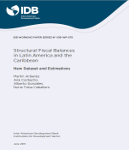Structural Fiscal Balances in Latin America and the Caribbean: New Dataset and Estimations
Date
Jun 2015
Data
Over the past decade, an increasing number of countries have began anchoring their fiscal policy frameworks in terms of rules that target the cyclically adjusted or structural (as opposed to actual) balance in an effort to overcome problems of procyclicality and fiscal volatility. The logic for doing so is in principle compelling: rule-based fiscal policies allow automatic stabilizers to work freely during the cycle and help accumulate fiscal surplus in good times. However, the estimation of structural balances is subject to a number of methodological challenges, including the degree of estimation uncertainty. This paper presents a range of estimates of the structural budget balance and uses them to analyze the cyclical behavior of fiscal policy in Latin America and the Caribbean. Based on an original dataset comprising detailed fiscal information from 20 countries across the region between 1990 and 2012, the paper finds that the range of estimates can be large for some countries, especially those that derive substantial fiscal revenue from commodity-related activities. In addition, the evidence shows that on average, the region has followed a procyclical policy pattern: a 1 percent increase in the output gap is associated with up to a 0.66 percentage point deterioration in the structural primary balance. This pattern hides substantial regional heterogeneity: procyclicality is more marked in countries that face large terms of trade shocks, but it can be counteracted by higher institutional quality.




